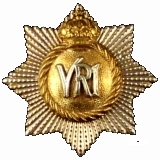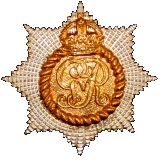
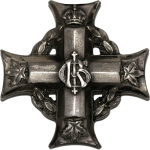
The First World War
Soldiers and Non-Commissioned Officers
of The Royal Canadian Regiment
477313 A/Sgt Albert Ernest Foster, M.M.
By: Captain Michael M. O'Leary, The RCR
Albert Ernest Foster was born 13 Jun 1895 somewhere in Ontario, he did not record a more specific location on his CEF attestation paper.
Foster enlisted in The Royal Canadian Regiment on 16 Oct 1914. A moulder by trade, Foster had no prior military service. He listed his mother as his next of kin; Mrs Ellen Foster of Oshawa, Ontario. Albert Foster is described in his attestation paper as 5-foot 11 inches in height, 140 pounds in weight, with a 35.5 inch chest. He had a medium complexion, blue eyes and light brown hair. Foster's original regimental number in The RCR was 20126, this would change to 477313 in late 1915 with the adoption of CEF service numbers by the Regiment.
Foster arrived at the Halifax station of The RCR on 20 Oct 1914, four days after his enlistment and a month after the main body of the Regiment had begun its garrison service in Bermuda. While Foster is not listed on the November 1914 nominal roll of The RCR serving in Bermuda, he must have arrived on the island as a reinforcement after that roll was compiled. In July 1915, along with the other soldiers of the Regiment, he was medically examined at Bermuda and on 7 Jul was found fit for Field Service as The RCR prepared for its departure from Bermuda en route to Europe.
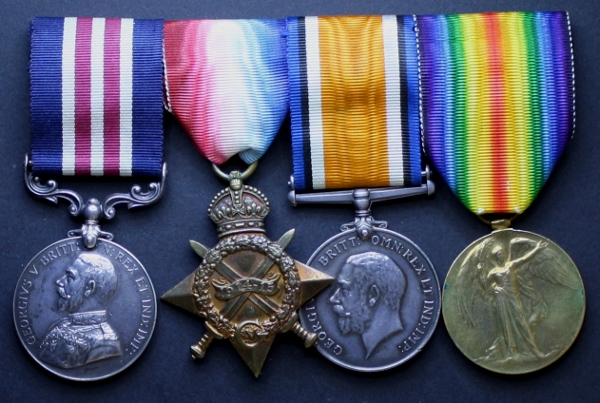
477313 Sergeant Albert Foster's medal group, consisting of the Military Medal, 1914-15 Star, British War Medal and the Victory Medal.
The Regiment returned from Bermuda to Halifax before sailing for England. While back at the Home Station, all soldiers were required to re-attest for overseas service with the Canadian Expeditionary Force. This re-attestation of the Regiment's soldiers was necessary because of some questions about the applicability of their Permanent Force terms of service for overseas wartime service. On 23 Aug 1915, Albert Foster confirmed his willingness to serve overseas with the CEF.
After crossing the Atlantic, Foster's service record provides only a few glimpses of his time in England before the Regiment crossed the channel into the theatre of war. The few surviving notes include his being discharged from hospital at Shornecliffe on 5 Sep 1915 although the reason for his hospitalization is not recorded. Also, on 10 Oct 1915, he forfeited one days pay for absence.
Foster accompanied the Regiment on its Channel crossing, entering France at Boulogne on 1 Nov 1915. The Regiment completed its training in France, being introduced to trench life by experienced battalions that were already serving in the front lines. Foster, however, would not complete that first winter in the trenches. On 26 Mar 1916 he was admitted to No. 10 Casualty Clearing Station, diagnosed with German Measles. The next day he was transferred to No. 7 General Hospital at St Omer, and would not return to duty with the Regiment until 13 Apr 1916.
Medical problems would continue to plague Albert Foster during the summer of 1916. On 15 Jul 1916 he would be admitted to No. 6 Canadian Field Ambulance for a "Hernia, Left Inguinal." He would be immediately transferred to No. 4 Canadian Field Ambulance and also diagnosed with "Myalgia", or muscular pain, of the back. His transport rearward continue via No. 10 Canadian Field Ambulance and onward to No. 3 Divisional Rest Station.
Foster would return to duty and by the fall of 1916 be serving in the Battalion's Scout Platoon. His courage on the battlefield would lead to an award of the Military medal for his action at Zollern Graben in September that year:
"At 7.30 o'clock on the morning of September 16, Lieut.Col. Hill moved his Headquarters to a dugout in a trench called Centre Way, whence, at 1 p.m., he was called to Brigade Headquarters and given orders for a continuation of the attack of the previous day. In this new operation, The Royal Canadian Regiment was to attack Zollern Graben on the right, while the 42nd Battalion attacked on the left. As a preliminary, the Patricias and the 49th Battalion were to bomb the Germans out of the section of Fabeck Graben to which they still clung after the action of the previous night. This the two battalions promptly accomplished."
"Meanwhile, Lieut.-Col. Hill had decided that his attack would be carried out by"D" Coy., under Major H. T. Cock, and "A" Coy., under Lieut. R. B. Penniman, with "C" Coy. in Battalion Support in Sugar Trench, and "B" Coy., extended to a full battalion frontage in the old Australian front line, as Battalion Reserve. The attacking companies were ordered to launch their assault from Fabeck Graben at 5 p.m. and were informed that a barrage would be laid on Zollern Graben at 4.40 p.m. Reconnaissances of the best routes to the attacking positions were meanwhile carried out under heavy fire, Privates A. E. Foster and B. McColl rendering in this work services of the greatest value."
"Moving off from the reserve positions at approximately 3.30 p.m., the attacking companies came under heavy rifle and machine-gun fire, which harassed them as they covered the 1,500 yards to their jumping-off positions and inflicted heavy losses. Despite the measure of disorganization that resulted, the companies reached Fabeck Graben eventually and, having established contact with the 42nd Battalion on the left, tensely awaited the crash of the supporting barrage."
"As arranged, the barrage was to have fallen on Zollern Graben at 4.40 p.m., but at this hour there was no sign of the concentrated shelling that had been expected. Minute after minute then passed, each an eternity to the men of The Royal Canadian Regiment and their Highland comrades on the left, who realized that, unless the barrage struck heavily on the objective before the attack at 5 p.m., death and disaster in No Man's Land inevitably awaited them." (The RCR 1883-1933, pp. 249-250)
Two weeks later, on 1 Oct 1916, Albert Foster would be decorated with an immediate award of the Military Medal. A citation card for Albert Foster's Military Medal award can be found in the Library and Archives Canada. Authorized by Major General L.J. Lipsett, CB, CMG, on 1 Oct 1916, the award would not be published in the London Gazette (Issue No. 29854) until 1 Dec 1916. The citation reads:
"Military Medal"
"On the 16th Sept; 1916, he made a preliminary reconnaissance of the ground. Having accomplished this successfully he then returned to Battn. and on the night mentioned voluntarily made nine round trips with important despatches. This man carried on under continuous heavy shell and M.G. fire, and in showing admirable coolness set a magnificent example to all those about him."
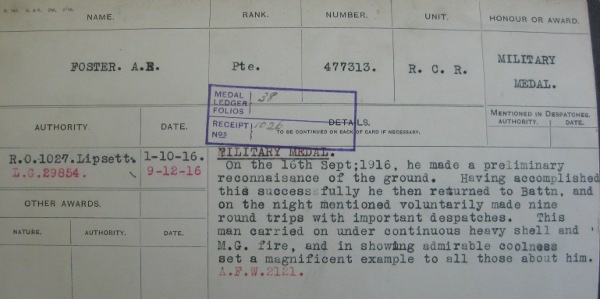
Citation card for 477313 Pte Albert Foster's Military Medal. (Library and Archives Canada document.)
A week after Foster's Military Medal was awarded, as the Regiment was preparing for its upcoming actions at Regina Trench, the immediate awards to members of the unit were announced:
"The Royal Canadian Regiment stood at Tara Hill, where it was announced that, for bravery in the unit's recent engagements, Private Dawson, a stretcher-bearer, had been awarded the Distinguished Conduct Medal and that the Military Medal had been won by Sergts. T. O'Connor and A. E. Gladwin, Privates Foster and McColl, of the Scout Section, and Private McGrath. From Tara Hill, the Regiment advanced on the afternoon of October 7 and at night relieved the 42nd Battalion in the front line." (The RCR 1883-1933; pp. 254)
After surviving the fighting at Regina Trench, Foster would again be hospitalized for his old complaint of muscle pains. He was one of the lucky ones, the Regiment's War Diary entry for 9 Oct 1916 reported seven other ranks killed, 68 wounded and 207 missing within three days of fighting. Although those numbers were yet to be finalized, it is telling that an attached narrative of operations noted that The RCR came out of the trenches after that tour only 140 strong.
On 13 Oct 1916, Foster was admitted to No. 13 General Hospital, Boulogne, for the returned symptoms of his myalgia. That same day he was administratively transferred from The RCR to the Canadian Casualty Assembly Centre (CCAC) at Shoreham on admission to No 13 General Hospital, Boulogne. Foster would be evacuated to England on the hospital ship H.S. Panama, and admitted to 3rd Western General Hospital at Cardiff on 15 Oct 1916. After ten days at Cardiff he would be transferred to the Canadian Convalescent Hospital, Bear Wood, on 26 Oct 1916 where he would spend 23 days before being transferred once more to the Canadian Red Cross Special Hospital, Buxton.
Foster would be taken back on the strength of the CCAC on 30 Oct 1916 and on that date awarded a medical category of "Aiii"; which deemed him to be "fit as soon as he was hardened by exercise." But Foster was not yet on the road to recovery. On 17 Nov 1916 he would again be hospitalized, this time at the Canadian Red Cross Special Hospital, Buxton, once again for a complaint of Myalgia. He would spend 26 days in hospital before being discharged on 12 Dec 1916. It was during this hospital stay that the publication of Foster's Military Medal would appear in the London Gazette (L.G. 29854, 9 Dec 1916).
Foster was medically examined for his fitness to serve on 13 Dec 1916. Following this examination, Capt E.T. Curran, CAMC, described his condition as: "Heart OK. General health good. Appetite good. Tongue clean. Pain in shins in damp weather, worse at night. Recommended as fit after graduated drill." Foster would finally be struck off the strength of the CCAC and transferred to the Nova Scotia Regimental Depot on 10 Mar 1917.
That same month he would be granted permission to marry, and the marriage approved on 15 May 1917. Albert Foster's wife was Mrs Ellen C Foster, living at 6 Railway Terr, Eastbourne, Sussex, England. Now a married man, Foster must have been working at presenting himself as a dependable soldier with potential for promotion. Accordingly, he was appointed Acting Lance Corporal (without pay) on 31 May 1917. Subsequently attached to Seaford on 23 Jul 1917, he was there appointed Acting Sergeant (also without pay) two days later. Foster's attachment to Seaford continued until 11 Sep 1917, at which time he returned to 2nd CCD and reverted to his Permanent Grade of Private. He was then transferred on 5 Oct 1917 to the 26th Canadian Reserve Battalion, where he remained until transferred again to the 17th Canadian Reserve Battalion at Bramshott on 15 Oct 1917.
Albert Foster continued to experience a disparity between his rank and responsibility and the pay he received. On 1 Dec 1917 he was appointed Acting Lance Corporal with pay, but the same date he was made an Acting Corporal without the pay for the new rank. The trust placed in Foster, however, did not bear out as he was "Reduced to Permanent Grade of Private for neglect of duty while in charge of a hut" on 12 Jan 1918.
Foster was struck off the strength of the 17th Res. Bn. on 22 Jan 1918 and posted to the Canadian Machine Gun Corps Depot (C.M.G.C.D.) at Seaford, While employed there, on 1 Feb 1918, he was appointed to be an Acting Sergeant. This time he was to receive the pay of his appointed rank while so employed.
While working at the Machine Gun Corps Depot, Foster's trips to hospital were not over. He was treated for a fracture of the nose on 20 Feb 1918, after he "was kicked on nose at football five days ago, bone broken." The treatment was not successful, and his file states that his nose "was straightened twice but deformity recurred." The next day, on 21 Feb 1918, Foster was admitted to No 14 Canadian General Hospital, Eastbourne, where his fractured nasal bones were "straightened under anesthesia, result fair." He would be discharged from hospital on 4 Mar 1918.
Albert Foster also managed to show that his ability to cross the paths of the authorities and the King's Regulations and Orders was undiminished. On 11 Mar 1918, he was again reverted to his Permanent Grade of Private, once more for a charge of Absence Without Leave (AWL). Foster's service as a Private did not last long and he was again appointed Acting Corporal (with pay, whilst employed) on 1 Apr 1918. The next day he was despatched On Command to Aldershot until 26 April, possibly as an instructor which would explain his acting promotion just before being tasked.
Foster's ability to find trouble always seemed to be catching up to him and leading to further medical care. On 7 Jun 1918 he was admitted to No 2 Eastern General Hospital, Brighton, with a diagnosis of V.D.S. (venereal disease, syphilis). At the same time, his hospitalization meant the end of his ongoing employment and his rank of "Acting Corporal, whilst employed" ceased with a reversion to his Permanent Grade of Private. On 13 Jun 1918, Foster was admitted to the Cherryhinton Military Hospital at Cambridge for further treatment. Foster was finally discharged from hospital on 12 Aug 1918 after 62 days treatment for venereal disease.
On 13 Aug 1918, Albert Foster was again taken in the strength of the C.M.G.C.D. at Seaford. Within a month, on 9 Sep 1918, he was again appointed to be an Acting Corporal (with pay whilst employed). This time he held his new rank until 30 Dec 1918 and was that date deprived of his appointment, also "forfeiting 2 days pay for A.W.L. from 2359 hours 26 Dec 1918 until 1000 hours 28 Dec 1918."
By early 1919, Albert Foster's service overseas was approaching an end. On 8 Jan 1919 he was sent on command to Rhyl and then on the 18th of January he was struck off the strength of the Canadian Expeditionary Force as he embarked for his return to Canada. On 25 Jan 1919, Foster disembarked at Halifax from the troopship S.S. AQUITANIA, a converted liner of the Cunard Line which saw service during the war as an armed merchant cruiser, a hospital ship and a troop transport. In the latter role she carried as many as 8000 troops on a single voyage.
On arrival in Halifax Foster was posted to the District Depot No. 2 Casualty Company (Exhibition Camp). He started his final leave four days after arriving in Canada, receiving "Leave and subsides" from 29 Jan 1919 to 12 Feb 1919.
On 18 Feb 1919, Albert Foster was subjected to his final discharge medical. That examination described him as being in good health and category Aii. The medical form does note primary syphilis in 1913, which was treated with 8 months mercurial, and treatment for same in June 1918. The fracture of the nose he suffered in March 1918 is also described, as well as his bouts of myalgia in his lower limbs (Nov 16) and trench fever (or German measles) (Mar 16), all with no after effects.
Albert Foster was struck off the strength of the CEF on 21 Feb 1919 and discharged at Toronto on demobilization. He was entitled to a War Service Gratuity. Foster's intended place of residence was identified as 204 Celina St, Oshawa, ON. This later changed to 393 Centre St.
There is one later mention of Albert Foster in regimental documents of The RCR. He is referred to by another Great War soldier of the Regiment in the August 1974 edition of Pro Patria, the regimental journal. In a letter discussing the identity of another regimental soldier, Dudley D. Spencer (CEF, RCR, 477869) noted the following:
"The only 477 man known to me lives in Toronto #477313 Sgt Abe Foster, MM, who won his decoration in 1916. This man was the greatest track man in the Canadian Army. His cups and trophies were numerous and he won all Regimental honours; Brigade, Division, Corps & Army championships, also at White City cleaned the board by his prowess as a runner of note. Even today he stands tall & as straight as a button stick. Every inch of his 6' frame portrays his athletic ability."
477313 Sergeant Albert Edward Foster died at Toronto, ON, on 4 March 1981.
Pro Patria
- The O'Leary Collection; Medals of The Royal Canadian Regiment.
- Researching Canadian Soldiers of the First World War
- Researching The Royal Canadian Regiment
- The RCR in the First World War
- Badges of The RCR
- The Senior Subaltern
- The Minute Book (blog)
- Rogue Papers
- Tactical Primers
- The Regimental Library
- Battle Honours
- Perpetuation of the CEF
- A Miscellany
- Quotes
- The Frontenac Times
- Site Map
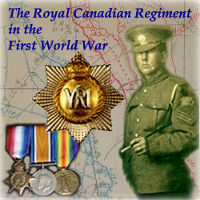
![]() The RCR in the Great War
The RCR in the Great War
![]() War Diary
War Diary
![]() Battle Honours
Battle Honours
![]() Battle Bars and The RCR
Battle Bars and The RCR
![]() The RCR Battle Bar Ledger (pdf)
The RCR Battle Bar Ledger (pdf)
![]() Honours and Awards
Honours and Awards
![]() Roll of Honour
Roll of Honour
![]() Prisoners of War
Prisoners of War
![]() Cemetery List
Cemetery List
![]() Cemetery Map
Cemetery Map
![]() Courts Martial
Courts Martial
![]() Officers
Officers
![]() RSMs of The RCR (1914-1919)
RSMs of The RCR (1914-1919)
![]() NCOs and Soldiers
NCOs and Soldiers
![]() An Officer's Diary (1914-1918)
An Officer's Diary (1914-1918)
![]() Recollections of a Nonagenerian (R. England) (1916-1919)
Recollections of a Nonagenerian (R. England) (1916-1919)
![]() On to Bermuda (1914-15)
On to Bermuda (1914-15)
![]() England and France 1915-1916 (Hayes; 1931)
England and France 1915-1916 (Hayes; 1931)
![]() Overseas with The Royals (1915)
Overseas with The Royals (1915)
![]() Regimental History Pamphlet (1917)
Regimental History Pamphlet (1917)
![]() Amiens (1918)
Amiens (1918)
![]() Cambrai (1918)
Cambrai (1918)
![]() Monchy-le-Preux (1918)
Monchy-le-Preux (1918)
![]() Under-aged Soldiers in The RCR
Under-aged Soldiers in The RCR
![]() Not All Were Volunteers; The RCR and the Military Service Act
Not All Were Volunteers; The RCR and the Military Service Act
![]() Sentenced to Death by Court Martial
Sentenced to Death by Court Martial
![]() The 7th Trench Mortar Battery
The 7th Trench Mortar Battery
![]() A Regimental Goat
A Regimental Goat
![]() Regiment and Family, Bermuda 1914-15
Regiment and Family, Bermuda 1914-15
![]() "March the Guilty Bastard In"
"March the Guilty Bastard In"
![]() Surrendered as Stowaway
Surrendered as Stowaway
![]() Re-Visiting the Great War Roll of Honour for The RCR
Re-Visiting the Great War Roll of Honour for The RCR
![]() Canadian Corps Trench Standing Orders (1916)
Canadian Corps Trench Standing Orders (1916)
